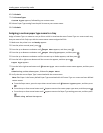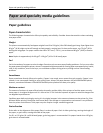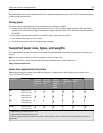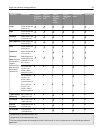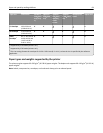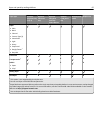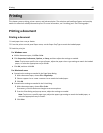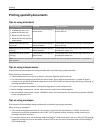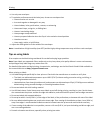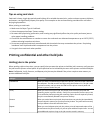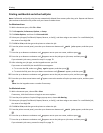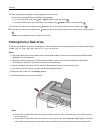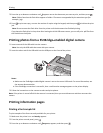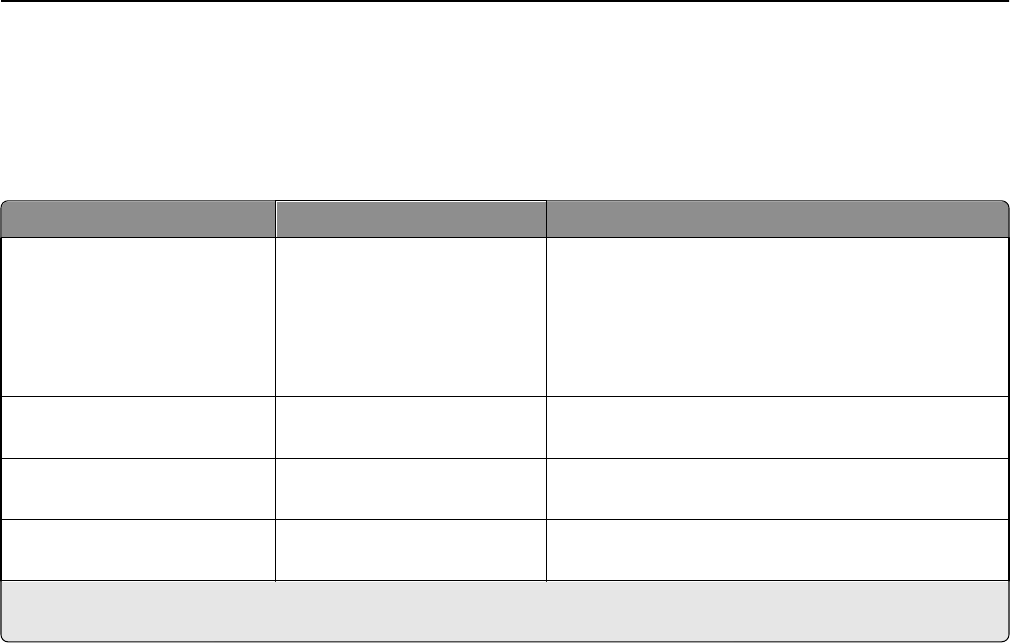
Printing specialty documents
Tips on using letterhead
Source or process Print side Paper orientation
• Standard 550‑sheet tray
• Optional 550‑sheet tray
• Optional 2,000‑sheet tray
• Optional 550‑sheet specialty
media drawer
Preprinted letterhead design is
placed faceup.
The top edge of the sheet with the logo is placed at the
front of the tray.
Duplex (two‑sided) printing
from trays
Preprinted letterhead design is
placed facedown.
The top edge of the sheet with the logo is placed at the
back of the tray.
Multipurpose feeder (simplex
printing)
Preprinted letterhead design is
placed facedown.
The top edge of the sheet with the logo should enter the
multipurpose feeder first.
Multipurpose feeder (duplex
printing)
Preprinted letterhead design is
placed faceup.
The top edge of the sheet with the logo should enter the
multipurpose feeder last.
Note: Check with the manufacturer or vendor to determine whether the chosen preprinted letterhead is acceptable for
laser printers.
Tips on using transparencies
Print samples on the transparencies being considered for use before buying large quantities.
When printing on transparencies:
• Feed transparencies from any tray or drawer, except the Optional 2,000‑sheet tray.
• Use transparencies designed specifically for laser printers. Check with the manufacturer or vendor to ensure
transparencies are able to withstand temperatures up to 170°C (338°F) without melting, discoloring, offsetting, or
releasing hazardous emissions.
• To prevent print quality problems, avoid getting fingerprints on the transparencies.
• Before loading transparencies, fan the stack to prevent sheets from sticking together.
• We recommend Lexmark part number 12A8240 for letter‑size transparencies and Lexmark part number 12A8241
for A4‑size transparencies.
Tips on using envelopes
Print samples on the envelopes being considered for use before buying large quantities.
When printing on envelopes:
• Use envelopes designed specifically for laser printers. Check with the manufacturer or vendor to ensure the
envelopes can withstand temperatures up to 190°C (374°F) without sealing, wrinkling, curling excessively, or
releasing hazardous emissions.
• For the best performance, use envelopes made from 90 g/m
2
(24 lb bond) paper. Use up to 105 g/m
2
(28 lb bond)
weight for envelopes as long as the cotton content is 25% or less. All‑cotton envelopes must not exceed 90 g/m
2
(24 lb bond) weight.
Printing 67



